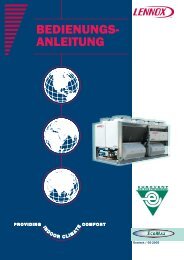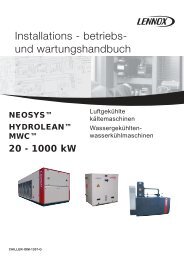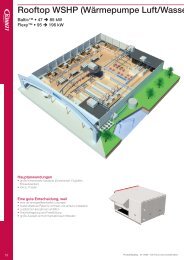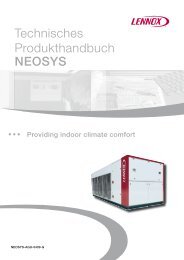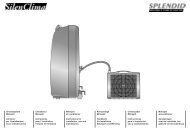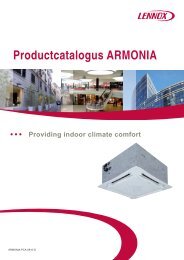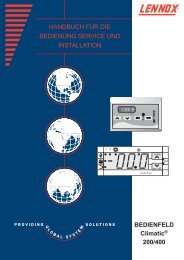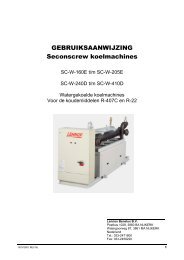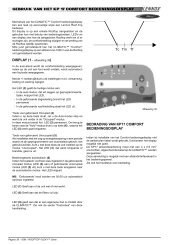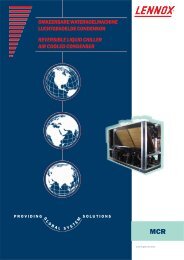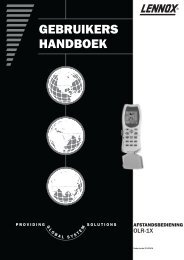LGA/LCA/LHA - lennox
LGA/LCA/LHA - lennox
LGA/LCA/LHA - lennox
You also want an ePaper? Increase the reach of your titles
YUMPU automatically turns print PDFs into web optimized ePapers that Google loves.
to first or second stage cooling demands. In all <strong>LGA</strong>/<br />
<strong>LCA</strong>210/240/300S units K1 (energized by A55), K2 (energized<br />
by A57), K14 and K146 (energized by A59) energize<br />
compressors B1, B2, B13, and B20 respectively.<br />
10−Blower Contactor K3 (all units)<br />
Blower contactor K3, used in all units, is a three-pole-doublebreak<br />
contactor with a 24VAC coil used to energize the indoor<br />
blower motor B3 in response to blower demand. K3 is energized<br />
by main control panel (A55).<br />
11−Outdoor Fan Relay K10, K68, K149, & K150<br />
(all units)<br />
Outdoor fan relays K10, K68, K149, and K150, used in all<br />
units, are DPDT relays with a 24VAC coil. In all <strong>LHA</strong> units K10<br />
(energized by A55), K68, K149, and K150 (energized by<br />
A61) energize condenser fans B4 (fan 1), B5 (fan 2), B21 (fan<br />
3), and B22 (fan 4) respectively, in response to thermostat demand.<br />
In the <strong>LGA</strong>/<strong>LCA</strong> units, the outdoor fan relays work the<br />
same; however, K10 is energized by A55, K68 is energized<br />
by A57, and K149 and K150 are energized by A59.<br />
12−Combustion Air Blower Relay K13<br />
(<strong>LGA</strong> units − first burner section)<br />
Combustion air blower relay K13, used in all <strong>LGA</strong> units, is a<br />
DPDT relay with a 24VAC coil. K13 is energized by the main<br />
control module A55 after a first stage heating demand from<br />
the thermostat. K13 remains energized throughout the heating<br />
demand. When energized, K13 N.O. contacts close to<br />
energize combustion air blower and begin a heating sequence.<br />
Pressure switch S18, located in the compressor<br />
compartment, closes as combustion air static pressure<br />
falls to �prove" combustion air blower operation. When<br />
S18 closes, the ignition controls and gas valves are energized<br />
to begin a heating sequence.<br />
13−Combustion Air Blower Relay K19<br />
(<strong>LGA</strong> units − second burner section)<br />
Combustion air blower relay K19, used in all <strong>LGA</strong> units, is a<br />
DPDT relay with a 24 VAC coil. K19 is energized by the gas<br />
valve control module A58 after a first stage heating demand<br />
from the thermostat. K19 remains energized throughout the<br />
first stage heating demand. When energized, K19 N.O.<br />
contacts close to energize the second heat section combustion<br />
air blower and begin second section heating sequence.<br />
Pressure switch S45, located in the compressor compartment,<br />
closes as combustion air static pressure falls to �prove" combustion<br />
air blower operation. When S45 closes, the second<br />
section of the ignition control and gas valve are energized to<br />
begin the second section heating sequence.<br />
Page 36<br />
14−Low Ambient Switch Relay K159<br />
(<strong>LGA</strong>/<strong>LCA</strong>180 units)<br />
Low ambient switch relay K159, used in all <strong>LGA</strong>/<br />
<strong>LCA</strong>156H/180 units, is a DPDT relay with a 24VAC coil. When<br />
one of the N.O. low pressure low ambient switches S11, S84,<br />
or S85 close (due to a pressure rise), K159 is energized. When<br />
K159−1 closes, A55 energizes K10 which in turn energizes<br />
outdoor fan motor B4. When K159−2 closes, A59 energizes<br />
K149 which in turn energizes outdoor fan motor B21. When<br />
the pressure lowers due to the outdoor fan motors cycling on,<br />
the pressure switch(es) will open and K159 will be de-energized.<br />
15−Low Ambient Bypass Fan (Kit) Relays<br />
K58 & K118 (<strong>LHA</strong> units)<br />
Low ambient bypass relays K58 and K118, used in all <strong>LHA</strong><br />
units, are N.C. DPDT relays with a 24VAC coil. K58 is wired in<br />
parallel with the first compressor reversing valve (L1) and is<br />
energized by A55. K118 is wired in parallel with the second<br />
compressor reversing valve (L2) and is energized by A61.<br />
When L1 is energized in the cooling cycle, K58 is also energized,<br />
opening K58-1. When L2 is energized in the cooling<br />
cycle, K118 is also energized, opening K118-1. Therefore,<br />
K58-1 and K118-1 are always closed during heating demand<br />
bypassing S11 and S84. This allows all fans to operate<br />
during heating demand and to cycle during cooling demand.<br />
16−Burner Controls A3 & A12 (<strong>LGA</strong> units)<br />
All <strong>LGA</strong> units have two burner controls. A3 controls gas heat<br />
section one, while A12 controls gas heat section two. The first<br />
gas heat section and the second gas heat section burner controls<br />
are identical. Both burner controls are factory set and are<br />
not adjustable. The control makes three attempts at ignition<br />
and then locks out the system if ignition is not obtained after<br />
the third trial. Reset after lockout requires only breaking and<br />
remaking thermostat demand. The control shuts off gas<br />
flow immediately in the event of a gas or power failure.<br />
Upon restoration of gas and power, the control will restart<br />
the ignition sequence and continue until flame is established<br />
or system locks out. For a more detailed description<br />
see the Gas Heat Components section.<br />
17−Power Exhaust Relay K65 (PED units)<br />
Power exhaust relay K65 is a N.O. DPDT relay with a<br />
24VAC coil. K65 is used in all <strong>LGA</strong>/<strong>LCA</strong>/<strong>LHA</strong> units<br />
equipped with the optional power exhaust dampers.<br />
K65 is energized by the economizer control panel (A56),<br />
after the economizer dampers reach 50% open (adjustable<br />
in ECTO). When K65 closes, the exhaust fans B10<br />
and B11 are energized.



